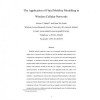Free Online Productivity Tools
i2Speak
i2Symbol
i2OCR
iTex2Img
iWeb2Print
iWeb2Shot
i2Type
iPdf2Split
iPdf2Merge
i2Bopomofo
i2Arabic
i2Style
i2Image
i2PDF
iLatex2Rtf
Sci2ools
MIS
2007
Springer
2007
Springer
The application of fluid mobility modelling in wireless cellular networks
Mobility models, synthetic or trace, try to accurately model the movement of a single user or a group of users. Models are used in simulators and emulators to investigate the consequences of mobility on new protocols or network management techniques. A limitation with current trace mobility models is they are based on empirical data which are limited to specific network types and environments. Limitations with synthetic models are that they are complex, computationally heavy, and lack realism. To address these issue a new approach needs to be taken. One such approach is the use of fluid mechanics and transport theory to represent user mobility. A model based on viscous free irrotational fluid mechanics with empirical data from pedestrian and vehicular studies provide a means of creating realistic group movement characteristics with smooth non random trajectories and smooth continuous velocity. The model is used in an example to provide boundary crossing rates for users in a cellula...
| Added | 27 Dec 2010 |
| Updated | 27 Dec 2010 |
| Type | Journal |
| Year | 2007 |
| Where | MIS |
| Authors | Ronan J. Skehill, Sean McGrath |
Comments (0)

